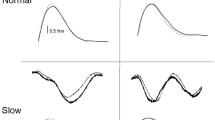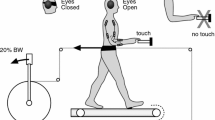Abstract
Recent experiments have identified neuromechanical interactions between the arms and legs during human locomotor movement. Previous work reported that during the rhythmic movement of all four limbs, the influence of the arms on reflex expression in the legs was superimposed on the dominant effect of the legs. This evidence was based upon studies using cutaneous and H-reflex modulation as indices of neuronal activity related to locomotion. The earlier H-reflex study was restricted to one phase of movement and to only a fixed H-reflex amplitude. Also, all four limbs were actively engaged in locomotor movement, and this led to the speculation that the effect from the arms could be underestimated by “swamping” of the conditioning during movement of the test limb. Work from the cat suggests that descending locomotor drive may be differentially specified for different motor unit populations in the hindlimb. Accordingly, details of interlimb coordination between the arms and legs in humans require further characterization and an examination of different populations of motor units as can be obtained from H-reflex recruitment curve (RC) parameters. Using modulation of H-reflex amplitudes across the entire ascending limb as neural probes for interlimb coupling, the present study evaluated the separated influences of rhythmic activity of the arms and leg on neuronal excitability of a stationary “test leg”. This three-limb “reduced” locomotion approach was applied using a stepping ergometer during the performance of three rhythmic movement tasks: arms (A); contralateral leg (L); and arms and contralateral leg (AL). Data were sampled at four different phases of the stepping cycle (using the moving leg as reference): start power (SP); end power (EP); start recovery (SR); and end recovery (ER). The main result was a large and significant influence of rhythmic AL activity on RC parameters of the H-reflex at EP and SP phases. However, the parameters (and thus motor unit populations) were differentially affected at each phase and task. For instance, a significant contribution of arms movement was noticed for H max (largest motor units) at EP phase (P < 0.05), but no changes was observed for other parameters related to lower reflex amplitude (e.g., H-reflex evoked with an input that elicited 50% of maximum reflex response during static condition; H@50%). On the other hand, at SR phase, the parameter H@50% was significantly affected during AL compared to L. It is suggested that the remote effect from arms rhythmic activity has been differentially manifested across motor unit populations for each phase of movement. These findings provide definitive evidence for interlimb coupling between cervical and lumbar oscillators in gating the excitability of reflex pathways to a leg muscle for different populations of motorneurons within the pool. This further supports the contention of similar functional organization for locomotor networks in the human when compared to other animals. Additionally, these data provide additional confirmation of the significant role of the output of neural control for rhythmic arm movement in modulating reflex excitability of the legs that is specifically adjusted according to the phase and task.





Similar content being viewed by others
References
Ashworth B, Grimby L, Kugelberg E (1967) Comparison of voluntary and reflex activation of motor units. J Neurol Neurosurg Psychiat 30:91–98
Balter JE, Zehr EP (2007) Neural coupling between the arms and legs during rhythmic locomotor-like cycling movement. J Neurophysiol 97:1809–1818
Bikmullina RK, Rozental’ AN, Pleshchinskiĭ IN (2006) Modualtion of the soleus H-reflex during dorsal and plantar flexions in the human ankle joint. Fiziol Cheloveka 32(5):104–109
Bruchthal F, Schmalbrugh H (1970) Contraction times of twitches evoked by H-reflexes. Acta Physiol Scand 80:378–382
Capaday C, Stein RB (1986) Amplitude modulation of the soleus H-reflex in the human during walking and standing. J Neurosci 6:1308–1313
Carroll TJ, Zehr EP, Collins DF (2005) Modulation of cutaneous reflexes in human upper limb muscles during arm cycling is independent of activity in the contralateral arm. Exp Brain Res 161:133–144
Carroll TJ, Baldwin ER, Collins DF, Zehr EP (2006) Corticospinal excitability is lower during rhythmic arm movement than during tonic contraction. J Neurophysiol 95:914–921
Crenna P, Frigo C (1987) Excitability of the soleus H-reflex arc during walking and stepping in man. Exp Brain Res 66(1):49–60
Crone C, Hultborn H, Mazieres L, Morin C, Nielsen J, Pierrot-Deseilligny E (1990) Sensitivity of monosynaptic test reflexes to facilitation and inhibition as a function of the test reflex size: a study in man and the cat. Exp Brain Res 81:35–45
Dietz V (2002) Do human bipeds use quadrupedal coordination? Trends Neurosci 25(9):462–467
Dietz V, Fouad K, Bastiaanse CM (2001) Neuronal coordination of arm and leg movements during human locomotion. Eur J Neurosci 14:1906–1914
Ferris DP, Huang HJ, Kao PC (2006) Moving the arms to activate the legs. Exerc Sport Sci Rev 34(3):113–120
Frigon A, Collins DF, Zehr EP (2004) Effect of rhythmic arm movement on reflexes in the legs: modulation of soleus H-reflexes and somatosensory conditioning. J Neurophysiol 91:1516–1523
Haridas C, Zehr EP (2003) Coordinated interlimb compensatory responses to electrical stimulation of cutaneous nerves in the hand and foot during walking. J Neurophysiol 90:2850–2861
Huang HJ, Ferris DP (2004) Neural coupling between upper and lower limbs during recumbent stepping. J Appl Physiol 97:1299–1308
Hundza SR, de Ruiter GC, Zehr EP (2010) Soleus H-reflex amplitude is unaffected by movement-related afferent feedback during arm cycling. Exp Brain Res (submitted)
Ivanenko YP, Poppele RE, Lacquaniti F (2006) Motor control programs and walking. Neuroscientist 12:339–348
Jankowska E (1992) Interneuronal relay in spinal pathways from proprioceptors. Prog Neurobiol 38(4):335–378
Kanda K, Burke RE, Walmsley B (1977) Differential control of fast and slow twitch motor units in the decerebrate cat. Exp Brain Res 29(1):57–74
Katz R, Morin C, Pierrot-Deseilligny E, Hibino R (1977) Conditioning of H reflex by a preceding subthreshold tendon reflex stimulus. J Neurol Neurosurg Psychiatry 40(6):575–580
Kernell D, Hultborn H (1990) Synaptic effects on recruitment gain: a mechanism of importance for the input-output relations of motoneurone pools? Brain Res 507(1):176–179
Kiehn O (2006) Locomotor circuits in the mammalian spinal cord. Annu Rev Neurosci 29:279–306
Klimstra M, Zehr EP (2008) A sigmoid function is the best fit for the ascending limb of the Hoffmann reflex recruitment curve. Exp Brain Res 186(1):93–105
Lamotte d’Incamps B, Meunier C, Zytnicki D, Jami L (1999) Flexible processing of sensory information induced by axo-axonic synapses on afferent fibers. J Physiol Paris 93(4):369–377
Loadman P, Zehr EP (2007) Rhythmic arm cycling produces a non-specific signal that suppresses soleus H-reflex amplitude in stationary legs. Exp Brain Res 179:199–208
Phadke CP, Klimstra M, Zehr EP, Thompson FJ, Behrman AL (2010) Soleus H-reflex modulation during stance phase of walking with altered arm swing patterns. Mot Control 14(1):116–125
Pierrot-Deseilligny E, Burke DC (2005) The circuitry of the human spinal cord. Its role in motor control and movement desorders. Cambridge University Press, Cambridge
Stoloff R, Zehr EP, Ferris DP (2007) Recumbent stepping has similar but simpler neural control compared to walking. Exp Brain Res 178:427–438
Tansey KE, Botterman BR (1996) Activation of type-identified motor units during centrally evoked contractions in the cat medial gastrocnemius muscle II. Motorneuron firing-rate modulation. J Neurophysiol 75(1):38–50
Wakeling JM (2004) Motor units are recruited in a task-dependent fashion during locomotion. J Exp Biol 207(22):3883–3890
Zehr EP (2002) Considerations for use of the Hoffmann reflex in exercise studies. Eur J Appl Physiol 86:455–468
Zehr EP (2005) Neural control of rhythmic human movement: the common core hypothesis. Exerc Sport Sci Rev 33:54–60
Zehr EP, Duysens J (2004) Regulation of arm and leg movement during human locomotion. Neuroscientist 10:347–361
Zehr EP, Haridas C (2003) Modulation of cutaneous reflexes in arm muscles during walking: further evidence of similar control mechanisms for rhythmic human arm and leg movements. Exp Brain Res 149:260–266
Zehr EP, Frigon A, Hoogenboom N, Collins DF (2004) Facilitation of soleus H-reflex amplitude evoked by cutaneous nerve stimulation at the wrist is not suppressed by rhythmic arm movement. Exp Brain Res 159:382–388
Zehr EP, Balter J, Ferris DP, Hundza SR, Loadman PM, StolaV RH (2007a) Neural regulation of rhythmic arm and leg movement is conserved across human locomotor tasks. J Physiol 582:209–227
Zehr EP, Klimstra M, Dragert K, Barzi Y, Bowden MG, Javan B, Phadke C (2007b) Enhancement of arm and leg locomotor coupling with augmented cutaneous feedback from the hand. J Neurophysiol 98:1810–1814
Zehr EP, Hundza SR, Vasudevan EV (2009) The quadrupedal nature of human bipedal locomotion. Exerc Sport Sci Rev 37(2):102–108
Acknowledgments
This work was supported by operating grants to Dr. E Paul Zehr from the Heart and Stroke Foundation of Canada (BC & Yukon) and the Natural Sciences and Engineering Research Council of Canada (NSERC). Dr. Mezzarane was supported by the Canadian Bureau for International Education (PDRF Program). Marc Klimstra was supported by the “Focus on Stroke” doctoral award from the Heart and Stroke Foundation of Canada.
Conflict of interest
The authors declare that they have no conflict of interest.
Author information
Authors and Affiliations
Corresponding author
Rights and permissions
About this article
Cite this article
Mezzarane, R.A., Klimstra, M., Lewis, A. et al. Interlimb coupling from the arms to legs is differentially specified for populations of motor units comprising the compound H-reflex during “reduced” human locomotion. Exp Brain Res 208, 157–168 (2011). https://doi.org/10.1007/s00221-010-2467-0
Received:
Accepted:
Published:
Issue Date:
DOI: https://doi.org/10.1007/s00221-010-2467-0




